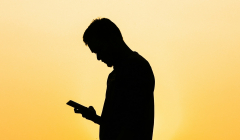
Should brands be doing more to help consumers ditch the doom scroll?
With increasing attention on the negative impact of social media on consumers’ mental health, a growing number of brands are advocating for IRL connection.

Research points to the commercial and creative effectiveness of outdoor advertising, but are brands paying attention

The most recent IPA Bellwether report sparked good news for marketers with UK budgets hitting a record high. Yet perhaps more notably for creatives, main media budgets, including big-ticket advertising campaigns broadcasted on television and radio, returned to growth after a reduction in Q1. Brands are braving to move away from short-termism and investing in long-term brand building once again.
While TVC continues to have an allure to clients, out of home (OOH) remains one of the most effective forms of brand building. According to System One, the recent TBWA Jaffa Cake out-of-home spot that states ‘It’s a cake, you biscuit’ surpassed TV for long-term commercial effectiveness, achieving a System One effectiveness score of 4.9 stars.
On social media, AI OOH and fake billboards that incorporate CGI such as JD Sports Big Ben campaign continue to go viral. Yet the industry debate on the trust deficit such campaigns arguably contribute linger on.
The creative firepower of OOH advertising out in the real world is arguably still an under-utilised creative platform. With this in mind, we asked industry leaders, has the marketing industry underestimated the creative firepower of out of home advertising?

100%! While everyone's buzzing about digital and social media (which ironically has seen a surge of faux OOH this year), traditional OOH is still out there making big, bold statements in the real world.
Think about it: billboards, bus stops, tube ads – they grab your attention in a way that scrolling on your phone simply can’t match. These ads are huge, unmissable, and right there in your face, creating a lasting impression because you can't just swipe past them. Plus, with tech advancements, OOH has seriously levelled up. Digital screens and interactive displays let brands keep things fresh and engaging in real-time, personalising content for local communities and reacting to the world around us.
And it’s not just about looking good. It’s about smart placement and context. A killer ad in a busy area doesn’t just get seen – it becomes part of the daily grind for people passing by. It’s a shared experience, something digital ads often lack.
Our agency has always been progressive with OOH, from weather-reactive creative (launching Smart Water in the UK, 2015), to more recent smart builds and anamorphic 3D ads for New York Bakery Co. We’ve taken ideas like Faux-OOH for Wilkinson Sword from social to real-world impact, with a billboard that foamed at the touch of rainwater. Creativity like this isn’t just cool – it’s impossible to ignore.
In short, the issue isn’t just about underestimating OOH advertising. It's largely about the lack of creative firepower directed toward it. When brands commit to bold, not normal ideas, they can and do truly stand out in the real world.

Radio ruled the world for decades. TV was king for many more.
Followed by the gripping wonder and doom of the social media entertainment rabbit hole
What next? Is OOH the new black for brands? Or is it a dying art?
When done properly, OOH can be more impactful and effective than TV. Andrew Tindall and System 1 tested TBWA\London’s Jaffa OOH campaign and called it out as “the most effective OOH we've tested in about five years”.
But the interesting thing about this particular OOH campaign is that it wasn’t born to be OOH.
An inherently subversive product, Jaffa is the cake in a family of biscuits. Our task was to showcase Jaffa’s loveable rogue spirit and unapologetic personality in a way that would drive buzz and cultural relevance to the brand.
At birth, this was a media agnostic brief and the idea later embraced the shape of comms that best did justice to its essence.
Born from a fan truth, the age-old debate whether it is a cake or a biscuit (and, for the record, ‘It’s a cake, bruv’), the idea ‘THE declaration: Jaffa is a cake!” is simple and bold visually and in spirit. We felt OOH was the perfect medium for such a declaration. In true idea-first fashion.
Why? In a world where brands (and everyone else) are trying to win the fight for attention as attention spans no more than 3 seconds these days, OOH is gaining momentum as it forces creativity to be brutally simple and instantly disruptive. So when you get that formula right, it’s a slam dunk.

Short answer - no. Not at all.
Long answer - show me any agency pitch deck and I’ll flip us through to the ‘If We Could’ section.
When done well OOH makes people go ‘Oh!”.
Even Collective, digital by DNA, is currently running a campaign for Zipcar where OOH features heavily and is performing extremely well. Try asking our creatives, who’ve been running around London papping a bus we wrapped this summer, if they’ve forgotten this particular power. You’ll have to catch them first.
So no, we haven’t forgotten. But in our ROI kink world where everything must be ultra-tracked (stunned and skinned) to within an inch of its life, it’s becoming harder and harder to get it made.
OOH enjoys the same strength as TV, relative to other channels. If a brand cares enough to put X on TV, a 48-sheet, a bus shell, an actual bus or Piccadilly bloody Circus for all to see - they must mean business. They must be credible.
Middling TV will beat middling OOH purely because of eyeballs. But good OOH will beat bad TV, and great OOH will wipe the floor with it - taking on a life of its own through snapping and sharing.
It’s the content that should get the most attention.
A good idea doesn’t care who has it, and also doesn’t care where it goes.
When it works - it’ll work in whatever format.

The industry may have underestimated the creative power of OOH advertising, particularly in its subtler forms. The intrigue surrounding Banksy’s work highlights the joy of individual interpretation, where each viewer finds personal meaning without being spoon-fed a message. Which begs another important question: must OOH always be literal to be effective? The British Airways' “A British Original” campaign exemplifies the power of minimalism, it doesn't force a message, it invites viewers to engage on their own terms, either finding personal significance or simply admiring the artistry.
Subtle OOH can have a profound impact on its environment and the community. Unlike traditional, loud advertising that clamours for attention, campaigns like BA’s can enhance a space, offering visual respite rather than noise. When an ad integrates seamlessly into its surroundings, it can be embraced by the community, much like how people revere Banksy’s work and mourn its defacement. Even with the rise in AI and tech savvy work, OOH still has the potential not just to coexist with its environment but to improve it.

The Jaffa Cakes ad illustrates one of the best things about OOH; when done well, it’s shareable.
The average person isn’t sending their mates a link to a 30” TV ad unless it’s off-the-charts groundbreaking, but they might snap a picture of a funny billboard they passed on their commute.
The question is - what is it about OOH that makes it shareable? We think it boils down to two things: simplicity and scale.
We all know that an OOH needs to be simple; it forces you to distill an idea down to its very core - “we’re a cake”.
Scale is a little more overlooked. We get served thousands of ads a day on our phones, it’s just second nature now to scroll past them before they’ve even started, a whopping great billboard (especially a good one) is a little harder to ignore.
Those things make OOH effective, but every half-decent billboard has them. As with any advertising, the tricky part is coming up with something novel and fresh enough that people want to share it. Weighing in on a famous debate (cake or biscuit) is a great tactic, others are creating a visual spectacle (think Nike’s Lionesses projections), using the space creatively (pretty much any Specsavers billboard), or creating something people can engage with.
As an example of the latter, we recently turned a billboard into a playable simulation of the prestigious St Andrews course to promote the AIG Women’s Open. No other medium could have demonstrated the campaign (“Never Stop Playing”) in the same way.

I think the marketing industry does appreciate how creative and exciting out of home is - which is why fake/faux OOH has become a thing. But fake OOH is really just a piece of online content, with limited reach and without the emotion that’s driven by in person experiences. Not to mention OOH is the only medium with the power to make people regularly share it on social, so you're killing two birds with one stone by keeping it real.
Awareness of OOH's creative potential isn't the issue - but awareness of the medium's effectiveness can be. When budgets are cut, marketers tend to focus on performance marketing channels (which just isn't enough) - with TV as the only ATL channel if any. However, we know that OOH has extensive reach and boosts the business effects of all other media - especially Search & Social. We also know that around 41% of media plans that include TV (100-149 TVRs) don’t have any OOH spend (source: Nielsen/Ebiquity 2023). This is clearly a huge opportunity for the taking.
Looks like you need to create a Creativebrief account to perform this action.
Create account Sign inLooks like you need to create a Creativebrief account to perform this action.
Create account Sign in